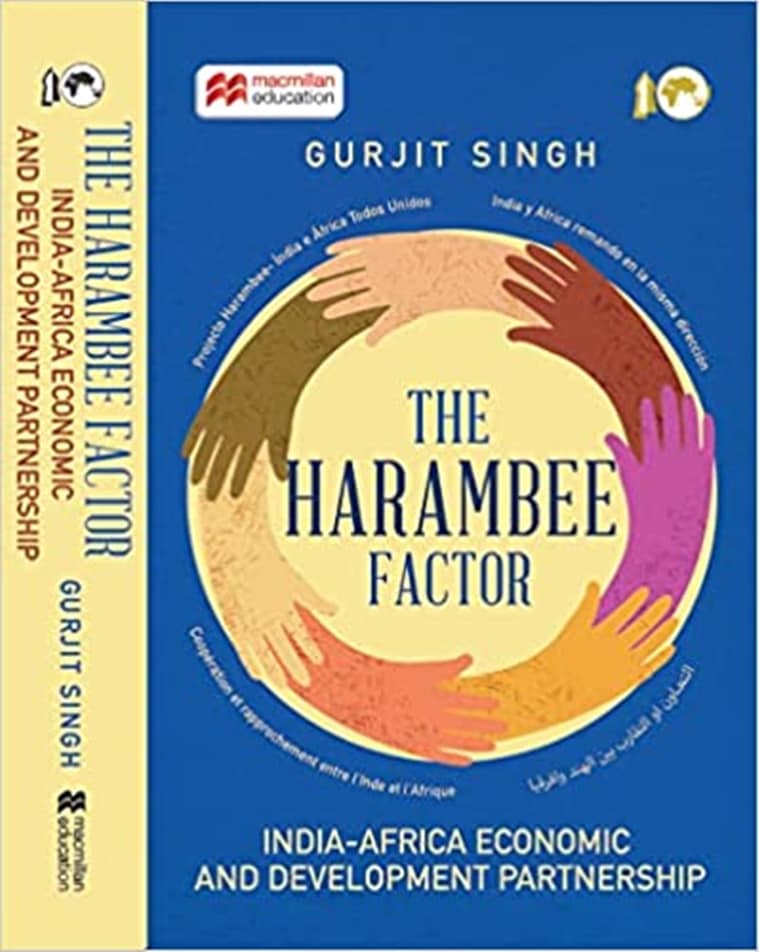Career diplomat Gurjit Singh traces the growing partnership between India and Africa in The Harambee Factor
India’s diplomatic and economic investment in Africa have proven to be mutually beneficial for both parties
 The Harambee Factor: India–Africa Economic and Development Partnership by Gurjit Singh; Macmillan Education; 456 pages; Rs 2,950 (Source: Amazon.in)
The Harambee Factor: India–Africa Economic and Development Partnership by Gurjit Singh; Macmillan Education; 456 pages; Rs 2,950 (Source: Amazon.in)The Harambee Factor: India–Africa Economic and Development Partnership is part of a refreshing trend of diplomats documenting their experiences and insights for wider public consumption, thereby also demonstrating the demand among readers to understand the inherent complexities of esoteric disciplines such as diplomacy. In this book, Gurjit Singh has distilled his decades-long experience of dealing with Africa to produce an objective and authoritative account of India-Africa relations.
The growing scholarship on Africa is reflective of the continent’s increasing influence in global affairs. As the author notes, Africa is the second-fastest growing region in the world after Asia, with its GDP having tripled in the past 15 years. The UN estimates that Africa’s population will double to 2.5 billion by 2050. Driven by its demographic dividend, a rising middle class, abundance of natural resources, growing investments, and greater continental unity, Africa will be an important global anchor for 21st century developments, foremost among them, economic growth and poverty reduction; urbanisation; achievement of SDGs; and climate-change mitigation.
Buy Now | Our best subscription plan now has a special price
Many scholars have studied the political and historical similarities between India and Africa, alluding to the common themes of cultural plurality and anti-colonial struggle. However, the economic and development axes of the partnership — central to India-Africa relations, particularly in the last 20 years — have not been studied in much depth. Utilising his unique vantage point of having engaged with Africa in various capacities, including as India’s Ambassador to Ethiopia and Djibouti; head of the Africa division at the MEA; and as Representative to the African Union, UNECA, and IGAD, the author has filled a significant gap in the literature by analysing India’s Africa policy from the lens of development and economic cooperation.
The book lays an overarching emphasis on the “spirit of cooperation” between India and Africa, with the evolution from bilateral alliances to continental partnership comprehensively explained. Even the decision to use the word Harambee for the title of the book — which means cooperation in Swahili and is considered by some to be of Indian origin — is a warm and conspicuous reference to the relationship. Details such as each chapter starting with an African proverb that pithily encapsulates certain facets of the partnership paradigm are flourishes that add to the underlying message of mutual respect for each other’s customs, traditions and diversity.
 In this book, Gurjit Singh has distilled his decades-long experience of dealing with Africa to produce an objective and authoritative account of India-Africa relations. (Source: Amazon.in)
In this book, Gurjit Singh has distilled his decades-long experience of dealing with Africa to produce an objective and authoritative account of India-Africa relations. (Source: Amazon.in)
At the crux of India’s engagement with Africa in the 21st century has been the India Africa Forum Summit (IAFS), first organised in India in 2008, then in Ethiopia (2011), and later in India again (2015). Established against the backdrop of instituting greater and regular high-level engagement, the IAFS represented a significant buttressing of the India-Africa relationship. It also reflected the evolution of the relationship into a more structured form, anchored in capacity enhancement and technical cooperation. Across the three tiers of pan-African, regional and bilateral levels; various institutions, sectoral partnerships and engagement mechanisms that were formalised have been discussed, including in areas of agriculture, textiles, education, rural development and civil aviation.
The reader will appreciate the author’s in-depth analysis of the summits where he was personally involved in the conceptualisation and development of many of the initiatives covered. In particular, his fascinating recounting of the reasons behind the many successes and failures of IAFS-II (when he was the summit’s “Sherpa”) provide a rare view inside the diplomatic processes of partnership-building. While the summits have paved a new direction for India-Africa relations, the author also cautions against certain shortcomings by suggesting that future summits need a more focused and institution-driven approach.
The leading components of the development cooperation axis, i.e., the 200 Line of Credit (LoC) agreements amounting to 12 billion dollars, have also been explored in detail. Indian LoCs were a vital step in the economic engagement strategy with Africa. The author’s conclusion on strengthening the FDI segment of the economic relationship — and its positive implications on trade and investment — is especially worth considering as Africa moves towards absorbing greater investments even as the private sector is seen to be playing a more meaningful role in development. India’s efforts in development cooperation also include grants, technical consultancy, and disaster and humanitarian aid.
One particular aspect of the development cooperation that the author highlights is the success of the capacity-building efforts in Africa, and the leading role of the India Technical and Economic Cooperation (ITEC) programme in that regard. Since its launch in 1964, ITEC has evolved to offer specialised courses and training programmes at the behest of partner nations. India has also offered courses to international and regional organisations in Africa. Other collaborative projects through non-state / civil actors such as SEWA and Barefoot College have also been well received. India is among the top five study destinations for African students. Scholarship and work opportunities mean that 27 per cent of the total foreign students in India come from Africa today. The Pan African E-Network Project (PANEP) project, despite being marred by implementation delays, has been important in knowledge sharing and dissemination of India’s technologies for public good in Africa.
A chapter has been devoted to the efforts made by the Modi government to strengthen India-Africa relations. The increased number of visits by Indian heads of state as well as 18 new Indian missions in the continent are just two among many examples that the author has cited to show the attention that the present Indian government has given to Africa. One memorable connection that draws attention is Prime Minister Modi’s address to the Ugandan Parliament in 2018 where he laid down the 10 guiding principles of India-Africa relations.
Unlike many other countries, India has constantly viewed Africa as an equal partner. India’s diplomatic and economic investment in Africa have proven to be mutually beneficial for both parties, and are underpinned by the shared belief that economic and territorial sovereignty are inviolable. Through personal accounts and surveys, the author has made the case that this approach has been appreciated by Africa.
Singh has penned an expansive and timely account of the growing economic and development partnership between India and Africa. It has the potential to become a reference point for practitioners and students of international relations, especially those who would like to study the recent evolution of India-Africa relations.
The writer is Minister of Petroleum and Natural Gas and Housing and Urban Affairs, Government of India






- 01
- 02
- 03
- 04
- 05

























